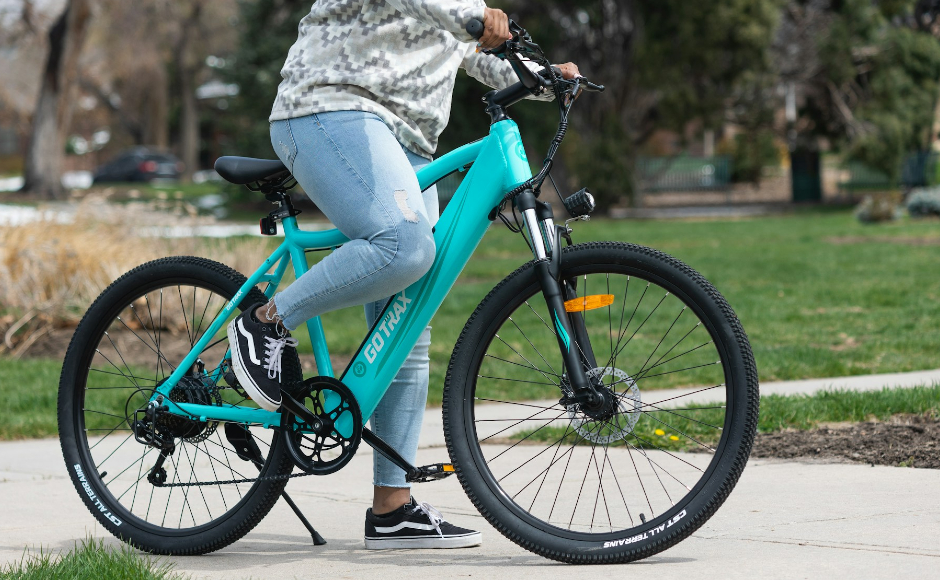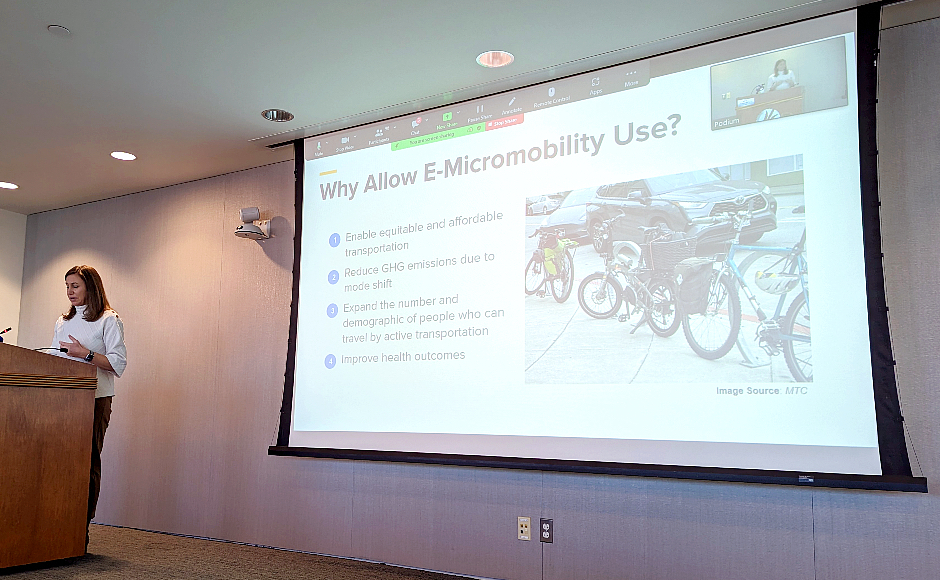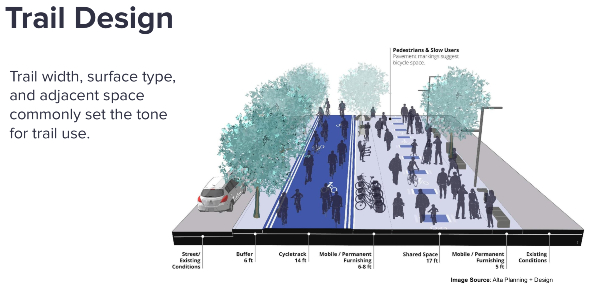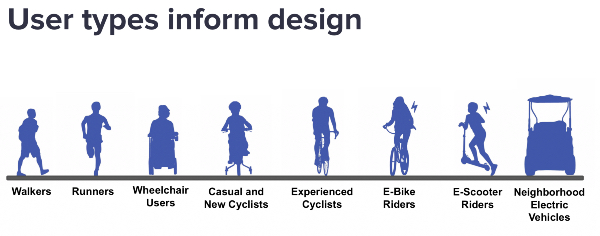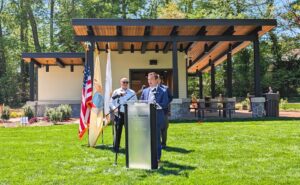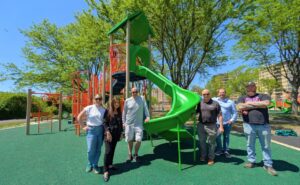As the popularity of small, electrified vehicles climbs, the Delaware Valley Regional Planning Commission e-Micromobility Summit addressed the need to build trails and roads to accommodate them.
By Matt Skoufalos | February 13, 2024
If you think you’ve noticed a greater number and variety of powered or battery-assisted bicycles on the road lately, it’s not a coincidence.
E-bikes have become especially popular in the past few years, with market-watchers noting a spike in their annual growth rate that’s outpaced sales of electric vehicles in the United States since at least 2018.
Given their increasing presence on roadways across North America, finding ways to design roads and trails to accommodate travelers who use e-bikes, e-scooters, and the like is becoming an issue of increasing relevance.
Last week, the Delaware Valley Regional Planning Commission (DVRPC) hosted an E-Micromobility Summit designed to foster conversations about how to build capacity for this growing class of transit users.
The U.S. Federal Highway Administration defines “micromobility” as “any small, low-speed, human- or electric-powered transportation device, including bicycles, scooters, electric-assist bicycles, electric scooters (e-scooters), and other small, lightweight, wheeled conveyances.” The “e-” prefix refers to low-speed, electrified versions of those vehicles, like e-bikes and e-scooters.
At the DVRPC summit, Jean Crouther of the Charlotte, North Carolina-based ALTA Planning, described e-micromobility planning as an aspect of “mobility justice,” opening up access to “health, economic opportunity, and safe and affordable transportation” for people who aren’t readily served by other modes of travel.
Like traditional bikes and scooters, e-bikes help people travel longer distances in shorter times, and may be a particularly helpful solution for travelers who may not be comfortable with or capable of using traditional bikes or scooters. By taking these kinds of users into consideration when designing trails and roadways, communities can best leverage the potential of e-bikes as mechanisms for broadening accessibility to public amenities.
“These are people who are excited to have an option where they feel comfortable and safe to get on trails,” Crouther said.
Just as in any other form of road or trail design, when making accommodations for e-micromobility, the best shared-use paths and trail networks consider the kinds of activities they’re intended to support, the kinds of riders who will use them, and how they fit within the broader context of the communities in which they’re situated.
A single trail rarely takes into account all types of users who will interact with it, Crouther said. The best-designed trails and roadways start by considering the safety of their most vulnerable users first, and branch out from there to address potential hazards, while considering the vehicle speeds, volumes, and their ability to maneuver on the roadways.
“[People are] buying e-bikes; they want to have a place to use them,” she said. “You have to make space for these users if you want them out there safely. Having a program where people ride on the sidewalk is not a solution; forcing people onto arterial roadways where they’re not comfortable with the speeds is also not a solution.
“New urban bikeway design is also suburban bikeway design,” Crouther said. “You have to make space for other road users. You have to build infrastructure.”
E-bike riders have also faced a perception that they’re more reckless, or travel at unsafe speeds as compared with traditional bicyclists, she said; however, case studies indicate that e-bike users may be generally compliant with the rules of the road, and travel within a mile per hour or so of traditional bicycles.
Crouther urged planners and municipal decision-makers to consider design factors that support and manage the safe use of e-bikes rather than outlawing the mode of travel simply out of concerns about its misuse.
“If you give good information, people generally are following the rules,” Crouther said. “There’s at least a lens to look through before prohibiting a device just based on the device.”

Camden Metro Police Lt. Zsakhiem James and a pile of confiscated ATVs in June 2019. Credit: Matt Skoufalos.
Those types of conversations have existed more than in just abstract environments, however.
Gibbsboro Mayor Ed Campbell attended the summit to get some insight in help managing an influx of ATV riders in his community.
Campbell described the experiences of pedestrians who use the Gibbsboro trail networks in his town as being complicated by other users who ride through on faster, off-road vehicles without regard for the safety of others.
“It’s a big problem,” the mayor said. “We have access all over to hundreds of acres of woods. [ATV riders] drive from neighboring towns, and ride main roads to get on the bikeway. We need to limit their access from the road.”
Campbell said his office is interested in “creative ways to be practical for recreation,” including finding ways to support trail users at different speeds by creating switchbacks, and erecting physical barriers to entry points. But he said he’s also stuck by the outsized impact that ATV riders have had on the rule-following users of the Gibbsboro trail networks.
“Our system is more focused on pedestrians, but it attracts a wide range of users,” he said. “We’re starting to design for 25 years from now.”
Chris Dougherty, Senior Planner and Project Manager for the Delaware Riverfront Corporation (DRC), which develops recreational uses along the river in Philadelphia, spoke about the rise of e-mobility as having “generated a need to communicate norms,” among users, especially about issues involving situational awareness, speed in congested areas, and general etiquette.
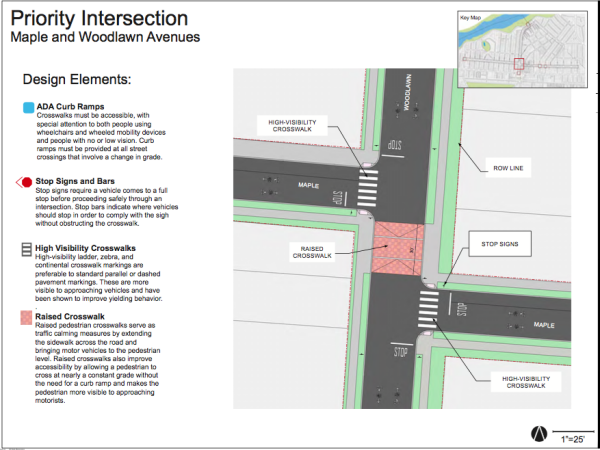
Plans for a bike boulevard along Maple Avenue in Collingswood include a raised thermoplastic intersection and traffic calming measures. Credit: Connect 2020.
DRC is borrowing some of its messaging for trail users from the Friends of the Katy Trail in Dallas, which reconsidered managing different users’ interactions after a cyclist hit a jogger who was wearing headphones and didn’t hear them approach.
Now DRC trail messaging includes notes like “Watch your speed, especially in congested zones,” and “Listening to music? Maybe only have one earbud in so you can hear others.”
Likewise, changes to the built environment — like adding textured thermoplastics to intersections to give them a different sensory feel — can help orient trail users to their surroundings at different speeds.
So can signage that encourages travelers to use different sections of the path by ability, speed, destination, or other designations.
“If you can make making the right choice as easy as possible, that’s where you want to be from a design perspective,” Dougherty said.
Laura Culp, Planning Manager for Indego Bikeshare, spoke about the massive popularity of e-bikes in the Indego fleet, which also includes traditional bicycles. For Philadelphians who don’t own a car, they can dramatically improve accessibility to reaches of the city they might not otherwise be able to visit.
“We joke that we are actually a battery-swapping company, not a bike share company,” Culp said. “Our e-bikes, docks, and systems, are all battery-powered. We get about 30 miles on one charge; it’s amazing how fast that goes away. We can’t keep them out there.”
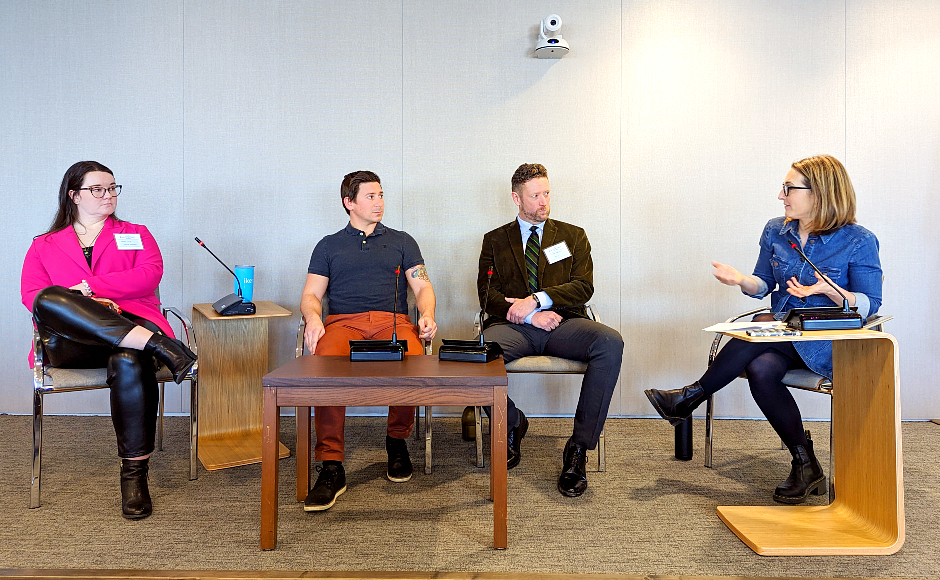
Emilia Crotty (right) leads panelists (from left) Laura Culp, James Bonanno, and Chris Dougherty at the DVRPC e-Micromobility Summit. Credit: Matt Skoufalos.
The biggest barriers to e-bike use are people who’ve never ridden a bicycle before or who don’t have a helmet to safely do so, Culp said.
The company offers a “learn to ride” program, and provides helmets to address these concerns.
“We really want people to understand it’s for everyone, but just because it’s a great resource, we still need to spend time showing the community it’s for them,” Culp said.
Asbury Park Transportation Director James Bonanno said that his community improved adoption of e-scooters among older generations of users by offering education courses in conjunction with their regional transportation management association (TMA), EZ Ride, and by offering seated as well as standing scooters.
“As a municipality, it’s important to look at the data and see how programs are performing, and adapt your program to see the demand and meet the demand of your riders,” Bonanno said.
“Education is the biggest part of this,” he said. “Bike infrastructure is still new to a lot of people.”

